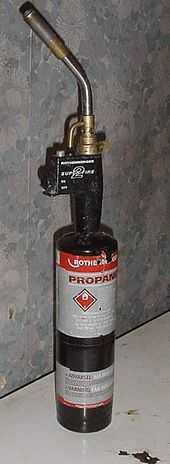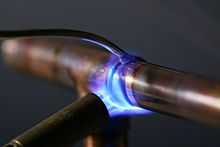Propane torch


A propane torch is a tool for burning the flammable gas propane (C3H8). The maximum adiabatic flame temperature a propane torch can achieve with air is 1,995 °C (3,623 °F). Some propane torches are also used with a tank of pure oxygen to achieve a flame temperature nearing 2,820 °C (5,110 °F).
The temperature in these flames is lower because of incomplete combustion, heat loss in combustion, oxygen quantity etc.

Propane torches are frequently employed to solder copper water pipes. They can also be used for some low temperature welding applications, as well as for brazing dissimilar metals together.
In addition to above, a large factor in the temperature of the flame is the percent of oxygen mixing with the propane. With air/fuel torches, since air contains about 21% oxygen, to obtain the maximum flame temperature with air, a very large ratio of air/fuel must be used. Even glass bead-making torches, which are essentially bunsen burners with an added air pump, can only achieve temperatures of 1,100 °C (2,010 °F).
With oxygen/propane torches, the air/fuel ratio is much lower. The stoichiometric equation for full combustion of propane with 100% oxygen is:
Unbalanced:
- C3H8 + O2 → H2O + CO2
Balanced:
- C3H8 + 5 (O2) → 4 (H2O) + 3 (CO2)
The only products are CO2 and water. This is only true with complete combustion.
To get the ratio, the atomic mass of C, H, and O must be determined.
- O = 16 g
- C = 12.01 g
- H = 1.008 g
- Propane weighs ((3×12.01) + (8×1.008)) = 44.094 g/mol.
- Oxygen gas weighs (2×16) = 32 g/mol.
The balanced equation shows to use 1 mol of propane for every 5 mol of oxygen.
- (5 × 32 g) / (44.094 g) = 160/44.094 = 3.63 grams oxygen gas for each gram of propane,
If using an oxygen/propane torch, the oxygen/fuel ratio is 3.63 by mass, 5:1 molar ratio.
For an air/propane torch: 3.63 g O2 × (100 O2)/(21% O2) = 17.28 g air/propane by mass,
- 23.81 mol O2 / 1 mol propane = 23.81:1 molar air/fuel ratio.
This means that it is much harder to achieve complete combustion with air than with oxygen.
If the propane does not receive enough oxygen, some of the carbon from the propane are left unburned: Complete combustion:
- C3H8 + 5 (O2) → 4 (H2O) + 3 (CO2)
Examples of incomplete combustion:
- C3H8 + 4 (O2) → 4 (H2O) + 2 (CO2) + 1 C
The extra carbon mole will cause soot and the less oxygen used the more soot will result. There are other unbalanced ratios where incomplete combustion products such as Carbon Monoxide (CO) are formed, such as:
- 6 (C3H8) + 29 (O2) → 24 (H2O) + 16 (CO2) + 2 CO